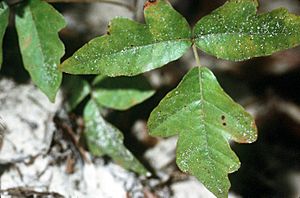Atlantic poison oak facts for kids
Quick facts for kids Atlantic poison oak |
|
|---|---|
 |
|
| Conservation status | |
| Scientific classification | |
| Genus: |
Toxicodendron
|
| Species: |
pubescens
|
| Synonyms | |
|
|
Atlantic poison oak (scientific name: Toxicodendron pubescens) is a plant that can make you very itchy! It's a type of shrub that usually grows straight up, reaching about 3 feet (1 meter) tall. Even though it's called "poison oak," it's not actually related to real oak trees.
Its leaves are about 6 inches (15 cm) long. Each leaf has three smaller parts, called leaflets. These leaflets are often a bit fuzzy and can look different from plant to plant. However, they usually look a lot like the leaves of a white oak tree. In the autumn, the leaves turn beautiful shades of yellow or orange. The plant also grows small, round fruits that are yellowish or greenish.
Contents
Where Does Atlantic Poison Oak Grow?
This plant is native to the southeastern parts of the United States. You can find it from Virginia all the way west to Texas and Oklahoma.
Where to Find It
Atlantic poison oak likes to grow in different places. You might see it in forests, in thick, bushy areas, or in dry, sandy fields.
Why Does Poison Oak Make You Itch?
All parts of the Atlantic poison oak plant contain a special oily substance called urushiol. This oil is what causes a very itchy rash, known as dermatitis, in many people. It's similar to the rash you might get from poison ivy.
How to Avoid the Rash
The best way to avoid getting a rash is to learn what Atlantic poison oak looks like and stay away from it. If you're going to be in an area where it might grow, it's a good idea to wear clothes that cover your arms and legs. This helps protect your skin from the urushiol oil. If your clothes touch the plant, make sure to wash them before you wear them again or handle them.
What Happens if You Touch It?
If you get urushiol on your skin, it can cause a rash. First, your skin might start to feel very itchy. Then, the area can become red and swollen, and you might see small bumps. If you scratch the itchy bumps, they can turn into blisters. It's important not to scratch, as this can make the rash worse or lead to an infection.
See also
 In Spanish: Roble venenoso atlántico para niños
In Spanish: Roble venenoso atlántico para niños


